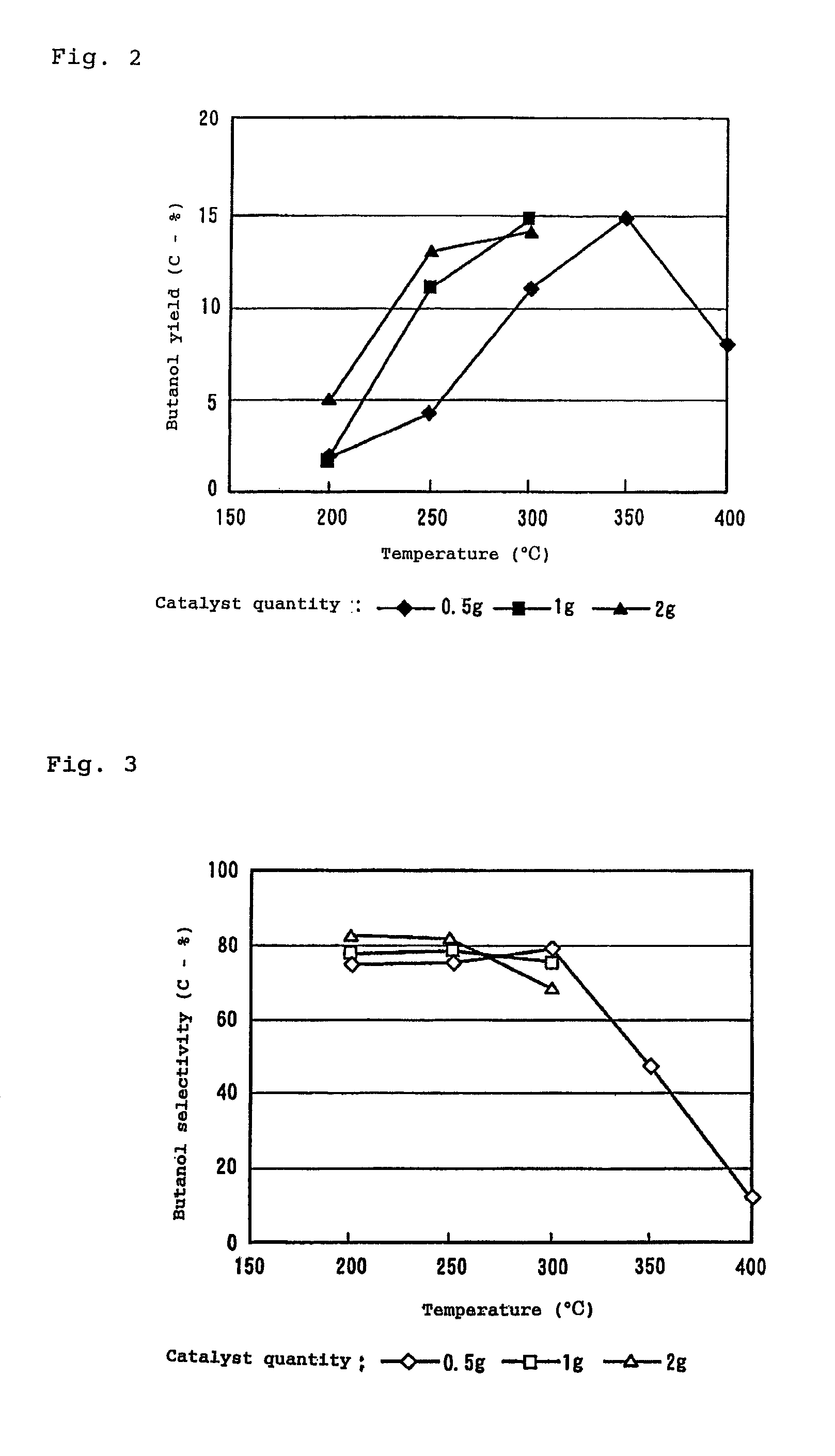Catalyst and alcohol synthesis method
a catalyst and alcohol technology, applied in the direction of physical/chemical process catalysts, metal/metal-oxide/metal-hydroxide catalysts, phosphorus oxyacids, etc., can solve the problems of difficult to obtain limited methods for obtaining butanol from biological resources, and unsatisfactory butanol selectivity, etc., to achieve high selectivity
- Summary
- Abstract
- Description
- Claims
- Application Information
AI Technical Summary
Benefits of technology
Problems solved by technology
Method used
Image
Examples
example 1
[0055]Fine powders of the above Samples (1) to (9) were molded into plate-like pellets of 250-500 μm. 0.5 g of the molded substance (catalyst) was filled in a glass tube (50 cm length, 10 mm diameter) and heated (dehydrated) as a pretreatment at 550° C. for 3 hours under a carrier gas atmosphere (Ar: Flow rate was 30 mL / min). Upon completion of the heating (dehydration) treatment, reaction was conducted at normal pressure under the conditions of 300° C. reaction temperature, 1.5 mol % ethanol concentration (partial pressure of ethanol=1.56 kPa), and 30 mL / min flow rate for the carrier gas. The reaction time was set for 2 hours.
[0056]A gas chromatography mass spectrometer (GC-MS, measurement conditions are as shown below) was used for identifying components of the reactant gas, and gas chromatography (GC, measurement conditions are as shown below) was used for measuring the conversion rate of ethanol and selectivity of the reactant gas (Detector: FID). Calculation was conducted based...
example 2
[0070]Using a molded form (catalyst) of strontium phosphate apatite (a major component of a catalyst of the present invention) of Sample (2), the conversion rate of ethanol (partial pressure=1.56 kPa) was varied by changing the catalyst quantity (0.5-2.0 g) and flow rate (30-60 mL / min) in Example 1. Then, distribution of the products was observed. The reaction time was set for 2 hours.
[0071]The results are shown in Table 2.
(Discussion on the Results of Example 2)
[0072]The more the conversion rate is increased, the more the selectivity of acetaldehyde and 2-buten-1-ol is decreased. On the other hand, selectivity of butylaldehyde and alcohol of C6 or more is increased. The selectivity of butanol was initially increased as the contact time increased, but then the selectivity decreased. Further, crotonaldehyde was detected in very minute amounts only at the early stage of the reaction.
[0073]These results suggests that it is a reaction mechanism routing through an aldol reaction as shown...
example 3
[0076]Using a molded form of strontium phosphate apatite of Sample (2), the catalyst quantity and temperature were varied under the same conditions as in Example 1, and the yield and the selectivity of n-butanol were monitored. The results are shown in FIGS. 2 and 3.
(Discussion on the Results of Example 3)
[0077]In order to further improve the yield and selectivity of butanol, the Sr—P catalyst was used and an attempt made to optimize the reaction conditions by varying the reaction temperature and catalyst quantity. According to FIGS. 2 and 3, which show changes in yield and selectivity of butanol, the yield of butanol is increased as the reaction temperature is increased when the catalyst quantity is 0.5 g and about 15 C-% is achieved at 350° C., but the yield is conversely decreased at 400° C. The selectivity is also increased as the temperature is increased and about 80 C-% was achieved at 300° C., but is decreased at 350° C. or higher due to side reactions or consecutive reaction...
PUM
| Property | Measurement | Unit |
|---|---|---|
| specific surface area | aaaaa | aaaaa |
| specific surface area | aaaaa | aaaaa |
| pressure | aaaaa | aaaaa |
Abstract
Description
Claims
Application Information
 Login to View More
Login to View More - R&D
- Intellectual Property
- Life Sciences
- Materials
- Tech Scout
- Unparalleled Data Quality
- Higher Quality Content
- 60% Fewer Hallucinations
Browse by: Latest US Patents, China's latest patents, Technical Efficacy Thesaurus, Application Domain, Technology Topic, Popular Technical Reports.
© 2025 PatSnap. All rights reserved.Legal|Privacy policy|Modern Slavery Act Transparency Statement|Sitemap|About US| Contact US: help@patsnap.com


